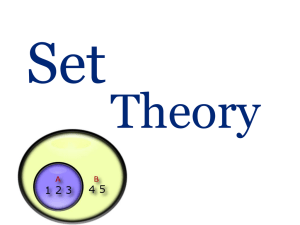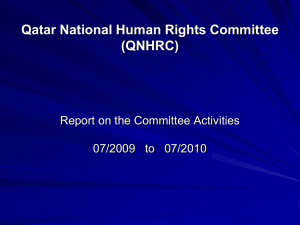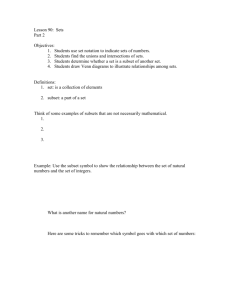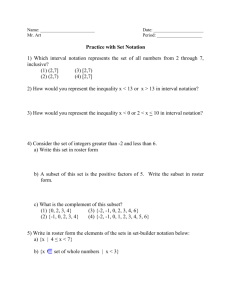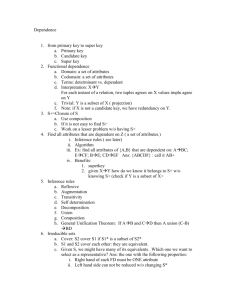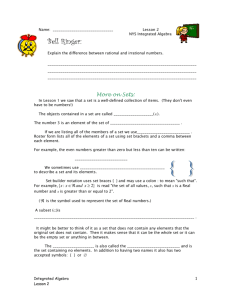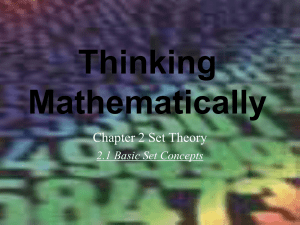Lecture1 - Qatar University
advertisement
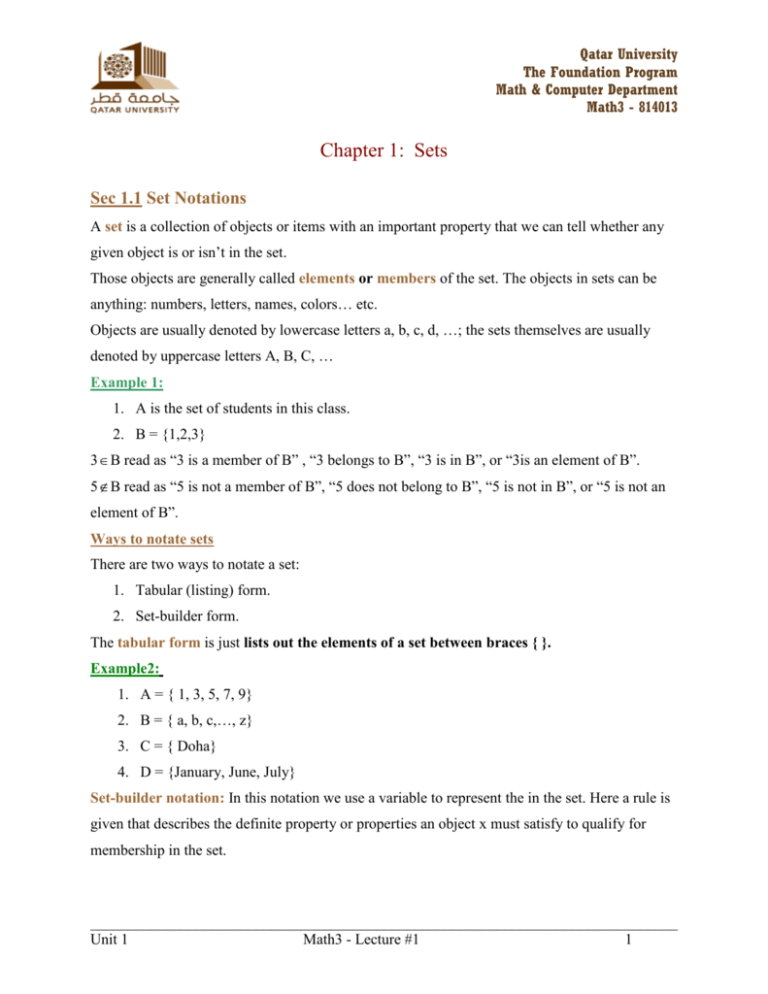
Qatar University
The Foundation Program
Math & Computer Department
Math3 - 814013
Chapter 1: Sets
Sec 1.1 Set Notations
A set is a collection of objects or items with an important property that we can tell whether any
given object is or isn’t in the set.
Those objects are generally called elements or members of the set. The objects in sets can be
anything: numbers, letters, names, colors… etc.
Objects are usually denoted by lowercase letters a, b, c, d, …; the sets themselves are usually
denoted by uppercase letters A, B, C, …
Example 1:
1. A is the set of students in this class.
2. B = {1,2,3}
3 B read as “3 is a member of B” , “3 belongs to B”, “3 is in B”, or “3is an element of B”.
5 B read as “5 is not a member of B”, “5 does not belong to B”, “5 is not in B”, or “5 is not an
element of B”.
Ways to notate sets
There are two ways to notate a set:
1. Tabular (listing) form.
2. Set-builder form.
The tabular form is just lists out the elements of a set between braces { }.
Example2:
1. A = { 1, 3, 5, 7, 9}
2. B = { a, b, c,…, z}
3. C = { Doha}
4. D = {January, June, July}
Set-builder notation: In this notation we use a variable to represent the in the set. Here a rule is
given that describes the definite property or properties an object x must satisfy to qualify for
membership in the set.
______________________________________________________________________________
Unit 1
Math3 - Lecture #1
1
Qatar University
The Foundation Program
Math & Computer Department
Math3 - 814013
Example 3:
1. A = {x : x is an odd integer less than 10 }
2. B = {x : x is a letter in English alphabet }
3. C = {x : x is the capital city of Qatar}
4. D = {x | x is a month that begins with J}
The above illustration would be read: “x, such that, x is a month that begins with J.”
Empty set: If a set has no elements, its called the empty set, or the null set and is denoted by the
symbol
or
.
Note:
1. {0} is not an empty set
2. {
} is not a way to indicate empty set
Example 4: If A {x : x 1} , then A =
2
Finite set: A finite set has a fixed number of elements.
Infinite set: A set is infinite if there is no end in counting its elements.
Example 5:
1. A = {a, b, c, …, z}
2. B = {x : x is a student in Qatar university}
3. C = {1, 2, 3, …}
A & B are finite sets, while C is infinite.
Equal sets: Two sets A & B are equal, written A = B, if and only if they have exactly the same
elements.
Example 6:
Let A = { a, b,2 ,5 , u} , B = { a, 5, b, 2, u}, and C = {a, b,2 ,5 ,v }
A = B since they both contains exactly the same elements.
A C since u A but u C.
______________________________________________________________________________
Unit 1
Math3 - Lecture #1
2
Qatar University
The Foundation Program
Math & Computer Department
Math3 - 814013
Note:
1. Order is not important in sets.
2. Repeating is not allowed in sets.
Subsets: If every element of set A is also an element of a set B, then we say that A is a subset of
B and write A B.
Example 7:
1. If A = { 2, 3} and B = {1, 2, 3} , then A B.
2. If S = { 1, 2, 4 } and E = { x : x is an even integer} , then S E since 1 S but 1 E.
3. {1, 2, 3, a, b} {a, b, 3, 1, 2}
Note:
1. The symbol for membership ( ) is used between a single element and a set, whereas the
symbol for subset ( ) is used between two sets.
2. A A
3.
is a subset of every set.
4. Two sets A and B are equal if and only if A B and B A.
Proper subset: We say that A is a proper subset of B if A B and A B
Example 8: Let A = {2, 4, 6} , B = { 2, 4, 6, 8, 10 }, and C = {4, 5, 6, 8 }
a) Use one of the symbols: , , , or , in each blank to make a true statement :
i) A__ B
ii) 3 __ B
iii) A __ C
iv) { 3 } __ B
v) 5 __ C
vi) { 4, 5 } __ C
vii) B __ { x : x is an even integer }
b) Determine whether each statement is true (T) or false (F):
i) 3 { 2, 3, 4 }
ii) { 3 } {2, 3, 4 }
iii) B = C
iv) 20 B
v) A
______________________________________________________________________________
Unit 1
Math3 - Lecture #1
3
Qatar University
The Foundation Program
Math & Computer Department
Math3 - 814013
Exercises 1.1
1. List the elements of the given set
a) x : x is adigit inthenumber 523,646
b)
c)
x : x is aletter intheword MATHEMATICS
x : x 10; x N
2. Write the following in set-builder form:
a) A = {1, 3, 5, …}
b) B = {4, 6, 8, …, 20}
c) C = {a, b, c, …, z}
d) D = {Saturday, Sunday, Monday, Tuesday, Wednesday, Thursday, Friday}
e) S = { 2 }
3. What does it mean to say that A B ?
4. Write the following using set notation
a) 5 does not belong to A
b) F contains S
c) R is a proper subset of P
d) A does not contain C
5. State whether the given statements are true or false
a) b, d, f f , d, b
b)
a, b a, b,c
c) A
d) 0
e) a, b, c a, b, c, d
6.
7.
8.
9.
f) x : x is agold medalist in 2004 Summer OlympicGames
Using the sets A and B determine whether each statement is true or false.
A {0,1,2,3,4,5,6}, B 1,3,5 and C 2,4,6
a) 0 C
b) C A
c) B A
d) B B
e) 2.5 C
Let S x : 3x 18, Is S = 6?
Does every set have a proper subset?
Let A a, b,c . Write all the subset of A
______________________________________________________________________________
Unit 1
Math3 - Lecture #1
4

